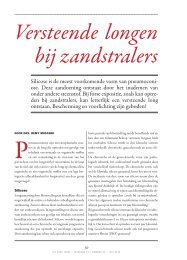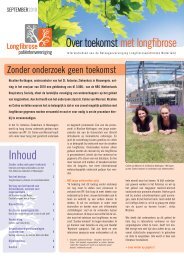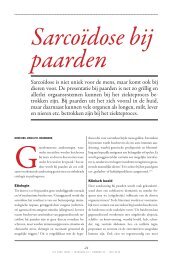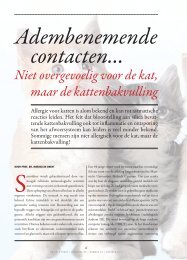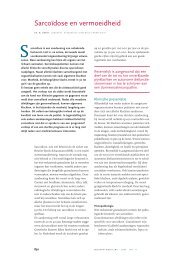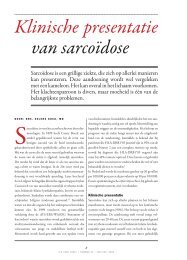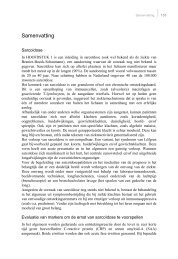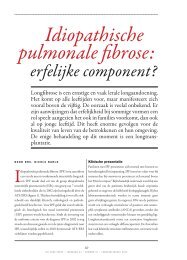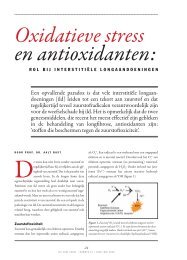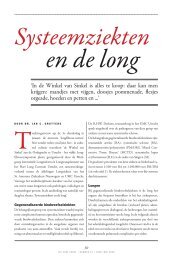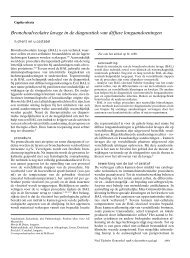Interpretation of bronchoalveolar lavage fluid cytology - ILD care
Interpretation of bronchoalveolar lavage fluid cytology - ILD care
Interpretation of bronchoalveolar lavage fluid cytology - ILD care
You also want an ePaper? Increase the reach of your titles
YUMPU automatically turns print PDFs into web optimized ePapers that Google loves.
<strong>Interpretation</strong> <strong>of</strong> BALF <strong>cytology</strong><br />
Introduction: Importance <strong>of</strong> standardization <strong>of</strong> handling BAL<br />
<strong>fluid</strong> samples<br />
Pr<strong>of</strong>. Robert P. Baughman, MD<br />
University <strong>of</strong> Cincinnati Medical Center<br />
Holmes, Room 1001<br />
Eden Avenue and Albert Sabin Way<br />
Cincinnati, Ohio 45267-0565<br />
e-mail: baughmrp@ucmail.uc.edu<br />
The concept <strong>of</strong> <strong>bronchoalveolar</strong> <strong>lavage</strong> (BAL) is not new. Bronchial <strong>lavage</strong> was a technique performed during rigid<br />
bronchoscopy, especially for obtaining samples in patients with tuberculosis. To sample the alveolar space,<br />
FINLEY described the use <strong>of</strong> the Matras catheter (used to perform bronchograms without a bronchoscope) to instill<br />
and immediately aspirate <strong>fluid</strong> [1]. However, the use <strong>of</strong> a flexible bronchoscope to obtain BAL <strong>fluid</strong> (BALF) samples<br />
was popularized by Dr. HERBERT REYNOLDS [2]. The technique has been widely used for both research and<br />
diagnostic indications.<br />
Technical aspects<br />
The technical aspects <strong>of</strong> the <strong>lavage</strong> procedure can not be ignored. Some <strong>of</strong> the controversy about interpreting<br />
<strong>lavage</strong> results can be traced to different centers having different results because <strong>of</strong> variations in the technique. As<br />
in any test, the details are important. This work deals with the cellular aspects <strong>of</strong> BAL.. In order to interpret the<br />
cellular information, one should be sure that the information has been obtained in a reliable manner. I will review<br />
some <strong>of</strong> the difficulties which have been described with various aspects <strong>of</strong> <strong>lavage</strong>.<br />
One <strong>of</strong> the difficulties inherent with BAL is the variability <strong>of</strong> the sampling [3]. The <strong>lavage</strong> process provides a<br />
washing <strong>of</strong> the alveolar space. In the process <strong>of</strong> washing the space, the amount <strong>of</strong> cells and <strong>fluid</strong> returned will vary.<br />
This variability may be on the basis <strong>of</strong> the underlying disease. Other factors also affect the variability: the amount <strong>of</strong><br />
<strong>fluid</strong> instilled [4,5], the amount <strong>of</strong> pressure used to aspirate the <strong>fluid</strong>, the method <strong>of</strong> collecting the aspirated <strong>fluid</strong> [6],<br />
and the handling <strong>of</strong> the aspirated <strong>fluid</strong>. In addition, different parts <strong>of</strong> the lung may have different BALF findings [7,8].<br />
For Pneumocystic carinii, <strong>lavage</strong> in the upper lobe may contain far more organism than <strong>lavage</strong> from the middle or<br />
lower lobe [9]. Some <strong>of</strong> the differences are due to operator differences, some are due to the conditions when the<br />
procedure is done.<br />
To deal with the variability <strong>of</strong> <strong>lavage</strong>, several groups have proposed using markers [10]. These include external<br />
markers, such as methylene blue [11], or internal markers, such as urea [12]. Unfortunately, none <strong>of</strong> these markers<br />
is perfect. This is because the alveolar space is not a water tight vessel. During the process <strong>of</strong> <strong>lavage</strong>, <strong>fluid</strong> and<br />
proteins are crossing from the lung <strong>fluid</strong> into the cells and blood stream. Also, internal proteins efflux into the lung<br />
<strong>fluid</strong> [3]. Because <strong>of</strong> this variability <strong>of</strong> <strong>lavage</strong>, a recent recommendations <strong>of</strong> an European Respiratory Society Task<br />
Force was to report acellular content <strong>of</strong> BALF per ml <strong>of</strong> aspirated <strong>fluid</strong> [13].<br />
Standardization <strong>of</strong> other aspects <strong>of</strong> BAL have been attempted. In the United States, KING et al. demonstrated that<br />
BAL interpretation could be improved by using a standard approach across several centers [14]. However, those<br />
recommendations have not been widely followed. The European Respiratory Society (ERS) had made a series <strong>of</strong><br />
recommendations on performing BAL [15,16]. In a recent report, the ERS has also included recommendations<br />
regarding the reporting <strong>of</strong> BALF analysis results. These recommendations are summarized in Table 1 [13].<br />
Introduction. R.P. Baughman. 2001. 1



